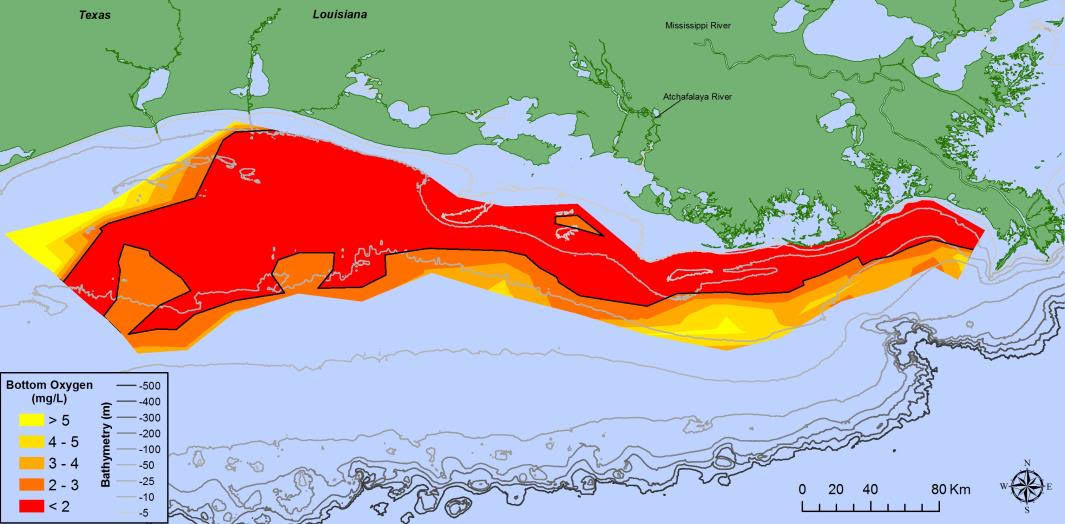
Houma man surrenders as Texas murder dragnet tightens
August 15, 2017OUR VIEW: Circumspection is a virtue
August 16, 2017The Gulf of Mexico’s dead zone – an area starved of oxygen that cannot support life – has reached the largest size documented since mapping began 35 years ago, researchers maintain in a new report.
The dimensions – this year the size of New Jersey – are of particular concern because they appear related to concerns expressed by shrimpers about their catch, particularly in Terrebonne Parish waters.
“They may be catching some close to shore,” said Dr. Nancy Rabalais, the oceanographer who pioneered Gulf dead zone research and who compiled the most recent report on its effects. “But they are not going to get anything between Terrebonne Bay and 25 or 35 miles offshore.”
That’s bad news, with the 2017 white shrimp season fast approaching.
Kimberly Chauvin of the David Chauvin Seafood Company in Dulac is among those in the industry who agree that something has been amiss, reporting catches of smaller shrimp overall, and the need for boats to go farther out for larger, more marketable shrimp. Going after shrimp farther out is costly in terms of time and most importantly the consumption of fuel. More fuel used chasing after shrimp farther out means less can be used in the trawling effort.
“Our boats out there now say there is nothing,” said Chauvin, referring to double-riggers that are permitted to trawl in federal waters beyond Louisiana’s three-mile inshore shrimp line.
While the dead zone is the only cause of woes for local shrimpers, she and others acknowledge that whatever effects it adds are certainly not helping.
The 2017 area of low oxygen, commonly known as the “dead zone” measured 8,776 square miles, according to Rabalais’ report.
The size is due in part, Rabalais said, to high nitrate concentrations in Mississippi River water discharging into the Gulf. The discharge itself was well above average when measured in May, a peak time for movement of water through the nation’s riverine system.
A notable feature of this year’s distribution of low oxygen is the mostly continuous band of extremely low oxygen concentrations alongshore, at the nearshore edge of the zone. Oxygen values there were very often less than 0.5 milligrams per liter and close to 0 milligrams per liter. The low oxygen waters also reached well up into the water column, at least on the eastern area of the map.
Absence of fish and shrimp in the lower layers of the water column are defining factors in a dead zone.
“The dead zone off the Louisiana coast is the second largest human-caused coastal hypoxic area in the global ocean and stretches from the mouth of the Mississippi River into Texas waters and less often, but increasingly more frequent, east of the Mississippi River,” Rabalais said.
The chemistry is complex.
The report says fresher, warmer water in the upper layer of the water column is separated from the saltier, colder water in the lower layer, resulting in a barrier to the normal diffusion of oxygen from the surface to the bottom.
The excess nutrients delivered by the river stimulate high phytoplankton biomass offshore, which fuels the coastal food web but also contributes to high carbon loading to the bottom layer. The decomposition of this carbon by bacteria in the bottom layer leads to the low oxygen that is not resupplied from the surface waters.
Rabalais was asked in an interview why, in the face of grim dead zone reports, anglers tend to find abundant fin-fish for the catching in the areas where the river meets the Gulf of Mexico. She said this is because the net effects of the phenomenon are most dramatic at the lower depths of the water, where some species – tuna and amberjack for example – do not swim.
“it depends where they are fishing and what they are fishing for,” Rabalais explained. “If they are after fish that live in the upper part of the water column, macerel or tuna, those fish are not affected by the dead zone which is something that happens lower in the water column and at the bottom.”
One of the monitoring project’s stations which indicated hypoxic conditions is very close to Cat Island Pass, a location close to the Terrebonne shore.
A hypoxic condition there may push some shrimp, which avoid the low-oxygen areas, north to the inshore waters. But other shrimp cannot cross the oxygen poor expanse, and so remain way off shore.
Massive farming operations and the runoff from their fertilizers and other chemicals are cited often as a major contributing factor to the dead zone in the Gulf of Mexico. Agribusiness firms, Rabalais and other scientists acknowledge, are responding with programs to encourage practices that will have better outcomes. But consistent monitoring Rabalais cautioned, is needed for the effects of those programs to be verified.
“The annual measurement of the hypoxic area also provides a critical scientific record of the trend of hypoxia in the Gulf to determine whether efforts to reduce nutrient loading upstream in the Mississippi River Basin are yielding results,” she stated. “Maintaining such a valuable ecological dataset can be difficult. However, without these continued observations and related research and modeling, the ability to predict changes in the ecosystem resulting from nutrient mitigation efforts in the Mississippi River watershed will be stymied.”









